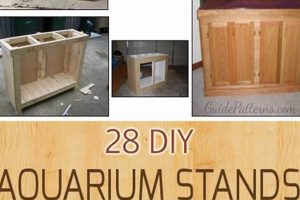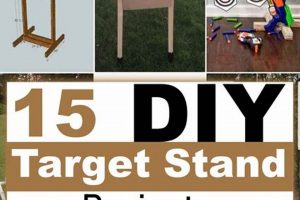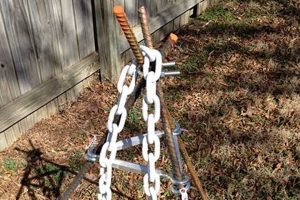The construction of customized media consoles from lumber offers a practical and aesthetically versatile approach to home entertainment organization. These handcrafted pieces provide tailored dimensions and design elements to accommodate specific television sizes and storage requirements. The appeal lies in the opportunity to create a unique furniture item while potentially reducing costs compared to purchasing pre-fabricated alternatives.
The significance of building one’s own media center lies in the ability to precisely match existing decor and maximize space utilization. Historically, this type of furniture construction has allowed individuals to exercise creative control over their living environments, reflecting personal style and preferences. Furthermore, engaging in such projects can foster a sense of accomplishment and provide a tangible connection to the home.
Subsequent sections will delve into the selection of appropriate lumber, essential tools and equipment, various design considerations, step-by-step construction processes, and finishing techniques related to creating a personalized entertainment storage solution. These elements are critical for ensuring structural integrity, aesthetic appeal, and long-term durability.
Construction Advice for Custom Media Consoles
The following recommendations aim to provide guidance during the construction of a custom entertainment center. Adherence to these principles promotes structural integrity, safety, and aesthetic refinement.
Tip 1: Material Selection: Opt for kiln-dried lumber to minimize warping or cracking post-construction. Hardwoods, such as oak or maple, offer superior durability compared to softwoods like pine.
Tip 2: Accurate Measurement: Precise measurements are critical for achieving desired dimensions and ensuring proper component alignment. Double-check all measurements before cutting any material.
Tip 3: Secure Joinery: Employ robust joinery techniques, such as mortise and tenon, dovetails, or pocket screws, to create strong and lasting connections between structural elements.
Tip 4: Adequate Support: Reinforce load-bearing sections of the structure, particularly the central platform, with additional supports to prevent sagging under the weight of the television and other equipment.
Tip 5: Cable Management: Integrate cable management solutions, such as pre-drilled holes or concealed channels, to maintain a clean and organized appearance.
Tip 6: Leveling Considerations: Incorporate adjustable leveling feet to compensate for uneven flooring and ensure the unit remains stable and level.
Tip 7: Finishing Application: Apply a durable finish, such as polyurethane or varnish, to protect the wood surface from scratches, moisture, and wear. Follow the manufacturer’s instructions for proper application techniques.
Careful consideration of these points will enhance the functionality, longevity, and visual appeal of the finished product. A well-executed entertainment center elevates the viewing experience and complements the surrounding environment.
The subsequent section will address common challenges encountered during construction and provide troubleshooting strategies to overcome potential obstacles.
1. Material Selection
Material selection is a foundational element in the successful execution of a do-it-yourself wooden television stand project. The choice of lumber directly influences the structural integrity, aesthetic quality, and longevity of the finished product. Selecting appropriate materials mitigates potential issues such as warping, cracking, or premature deterioration. For example, using untreated pine in a humid environment can lead to dimensional instability and fungal growth, ultimately compromising the stand’s structural integrity and appearance. Conversely, employing kiln-dried hardwood, such as maple or oak, offers enhanced resistance to moisture and wear, resulting in a more durable and visually appealing outcome. The initial investment in quality materials contributes directly to the long-term value and functionality of the self-made piece.
Practical applications of informed material selection are evident in the diverse range of achievable styles and functionalities. Reclaimed wood, for instance, introduces a rustic aesthetic and aligns with sustainable practices, but necessitates careful inspection for structural soundness and pest infestations. Sheet goods, such as plywood or MDF, provide cost-effective alternatives for larger panels or concealed components, but require edge banding to conceal the core and enhance visual appeal. Consideration of the intended load-bearing capacity is also crucial; heavier televisions necessitate thicker lumber or reinforced structures to prevent sagging or failure. The interplay between material properties and design requirements underscores the importance of thoughtful material selection in optimizing both performance and aesthetics.
In summary, material selection exerts a decisive influence on the overall success of a self-constructed wooden media console. While budgetary constraints may influence choices, prioritizing durability and suitability for the intended application is paramount. Challenges may arise in sourcing specific materials or ensuring consistent quality; however, diligent research and careful inspection mitigate these risks. A thorough understanding of wood properties and their impact on structural performance contributes to the creation of a functional, aesthetically pleasing, and enduring piece of furniture.
2. Design Planning
Design planning constitutes a critical precursor to the successful fabrication of a customized wooden television stand. The absence of a comprehensive design phase invariably leads to inefficiencies, structural deficiencies, and aesthetic compromises in the final product. This phase involves the meticulous consideration of dimensions, weight-bearing capacity, storage requirements, and integration with the surrounding environment. For example, failing to account for the weight of a large television during the design process may result in a structurally inadequate stand prone to sagging or collapse. Similarly, neglecting to plan for cable management results in a visually cluttered and functionally compromised piece of furniture.
Effective design planning necessitates a detailed understanding of spatial constraints and user needs. This includes accurately measuring the available space, assessing the dimensions of the television and other electronic devices, and determining the desired storage capacity for media components and accessories. Furthermore, the design should incorporate considerations for ventilation to prevent overheating of electronic equipment. Practical application of design principles involves creating detailed sketches or utilizing computer-aided design (CAD) software to visualize the final product and identify potential conflicts or inefficiencies. A well-defined plan serves as a blueprint for the construction process, minimizing errors and ensuring a cohesive and functional outcome. For instance, creating a design that doesn’t consider ventilation can cause the TV to overheat, but creating holes to manage temperatures can solve this problem.
In summation, design planning functions as the foundation upon which a successful customized wooden television stand is built. Challenges inherent in this phase include reconciling aesthetic preferences with structural requirements and adapting to unforeseen spatial limitations. However, meticulous planning and attention to detail mitigate these risks, resulting in a furniture piece that is both functional and aesthetically pleasing. The correlation between comprehensive design planning and a satisfactory final product underscores the importance of investing time and effort in this initial phase. This investment leads to an end product that fits seamlessly into its intended environment and meets the specific needs of the user, avoiding costly modifications and alterations down the line.
3. Joinery Techniques
Joinery techniques constitute a critical element in the structural integrity and aesthetic appeal of a self-made wooden television stand. The selection and execution of appropriate joinery methods directly influence the stand’s ability to bear weight, resist racking forces, and maintain its form over time. Inadequate joinery can result in instability, premature failure, and compromised visual aesthetics. For instance, a television stand constructed with poorly executed butt joints and insufficient adhesive may exhibit instability under the weight of the television and associated equipment, leading to potential structural collapse. Conversely, employing robust techniques such as mortise and tenon, dovetail, or properly executed pocket hole joinery enhances the strength and durability of the connections, ensuring long-term stability.
The practical application of joinery techniques extends beyond mere structural considerations. The choice of joinery method also influences the aesthetic character of the piece. Dovetail joints, for example, contribute a distinctive visual element that can enhance the overall design, while concealed joints such as pocket screws or biscuits offer a cleaner, more minimalist aesthetic. The selection of joinery techniques should therefore align with the desired style and functional requirements of the television stand. Furthermore, the skill and precision with which joinery techniques are executed directly impact the quality and longevity of the furniture. A well-executed mortise and tenon joint, for instance, provides superior strength and resistance to racking forces compared to a poorly executed butt joint, even when both are reinforced with fasteners. Proper alignment, tight fits, and appropriate adhesive selection are essential for maximizing the effectiveness of any joinery technique.
In summary, joinery techniques are integral to the success of a do-it-yourself wooden television stand project. The understanding and skillful application of these techniques directly correlate with the structural integrity, aesthetic appeal, and long-term durability of the finished product. While challenges may arise in mastering complex joinery methods or adapting them to specific design constraints, the investment in learning and practicing these skills yields significant benefits in terms of the quality and longevity of the handmade furniture. The proper selection and execution of joinery techniques are not merely functional requirements; they represent a critical element in the creation of a lasting and visually appealing piece of furniture.
4. Structural Support
Structural support is a paramount consideration in the design and construction of any do-it-yourself wooden television stand. The television stands capacity to safely and effectively bear the weight of the television, along with other media components, is directly determined by the adequacy of its structural design. Failure to address structural support sufficiently can result in catastrophic failure, leading to damage to the television and potential injury. The selection of appropriate materials, joinery techniques, and support structures are therefore essential components of the design and construction process. For example, a stand constructed with thin lumber and inadequate bracing may buckle under the weight of a large, modern television, whereas a design incorporating thicker lumber, strategically placed supports, and robust joinery will provide the necessary stability.
Practical applications of structural support principles are evident in various design elements commonly found in wooden television stands. Center supports, for instance, are frequently employed to prevent sagging in the middle of the stand, particularly when supporting heavier televisions. Reinforcing corners with gussets or corner blocks enhances rigidity and resistance to racking forces. The use of solid wood panels for the base and top, rather than thinner sheet materials, also contributes to overall structural integrity. Furthermore, the distribution of weight across the stand’s footprint is a critical consideration; a wider base provides greater stability than a narrow one. Understanding load-bearing capacity and implementing appropriate structural reinforcements is essential for ensuring the safety and longevity of the handmade television stand.
In summary, structural support is an indispensable element in the design and construction of a DIY wooden television stand. The interplay between material selection, joinery techniques, and the implementation of reinforcing elements directly influences the stand’s ability to safely and effectively support its intended load. While design aesthetics and functionality are important considerations, they should not compromise the structural integrity of the piece. A thorough understanding of structural principles and the application of appropriate construction techniques are essential for creating a safe, durable, and aesthetically pleasing television stand that will provide years of reliable service.
5. Cable Management
Effective cable management is an integral component of a professionally finished wooden television stand constructed via do-it-yourself methods. The inherent accumulation of power cords, HDMI cables, and various other connecting wires associated with modern entertainment systems necessitates a deliberate approach to organization. Without such planning, the visual appeal of the stand is diminished, and accessibility for maintenance or reconfiguration becomes significantly complicated. Untangled cables not only create an unsightly appearance but also pose potential tripping hazards and impede airflow, potentially contributing to overheating of electronic components. Consequently, integrating strategic cable management solutions is essential for maximizing both the aesthetic and functional value of the handcrafted stand. For example, consider a visually stunning stand built with meticulous detail, rendered less impressive by a chaotic tangle of wires obstructing the clean lines and craftsmanship.
Incorporation of cable management can encompass a variety of techniques, each tailored to the specific design and requirements of the wooden stand. Pre-drilled holes in the rear panels facilitate the routing of cables from one compartment to another, minimizing their visibility. Concealed channels or raceways integrated into the design provide a more sophisticated means of hiding cables. Furthermore, the implementation of Velcro straps or cable ties to bundle and organize wires prevents them from becoming entangled. Practical applications include designing openings large enough to accommodate multiple cables while ensuring structural integrity is maintained and using contrasting colored ties to differentiate cables for easy identification during troubleshooting or component replacement.
In summary, thoughtful cable management elevates a do-it-yourself wooden television stand from a merely functional piece of furniture to a visually appealing and well-organized entertainment center. While the construction of the stand itself requires woodworking skills and attention to detail, proper cable management necessitates foresight and strategic planning. The resulting improvement in both aesthetics and functionality underscores the importance of considering this aspect as an integral part of the overall design and construction process. Overcoming the challenge of integrating effective cable management ultimately enhances the value and enjoyment derived from the handcrafted piece.
6. Finishing Application
The finishing application represents a critical stage in the creation of a self-assembled wooden television stand, directly impacting both its aesthetic appeal and its long-term durability. The absence of a proper finish exposes the underlying wood to environmental factors, such as moisture and ultraviolet radiation, leading to degradation and diminished aesthetic value. Conversely, a well-executed finish protects the wood from damage, enhances its natural beauty, and prolongs the lifespan of the furniture piece. For example, a stand left unfinished may warp or crack due to changes in humidity, while a stand treated with a protective coating remains stable and visually appealing for an extended period. The choice of finishing material and the application technique significantly influence the final outcome.
Practical applications of finishing techniques range from simple stain and varnish combinations to more complex multi-layer systems. Staining allows for the alteration of the wood’s color, while varnish provides a protective barrier against scratches, moisture, and UV light. Proper surface preparation, including sanding and cleaning, is essential for ensuring adequate adhesion of the finish. Application methods, such as brushing, spraying, or wiping, each offer distinct advantages and disadvantages depending on the type of finish and the desired level of control. For instance, spraying typically results in a smoother, more even finish, while brushing allows for greater control in applying thicker coatings. The selection of the appropriate technique depends on the desired aesthetic outcome and the skill level of the individual applying the finish.
In summary, the finishing application is an indispensable component in the construction of a DIY wooden television stand. It provides both aesthetic enhancement and essential protection for the wood. Challenges may arise in selecting the appropriate finishing material and mastering the application technique, but these are readily overcome through research and practice. The ultimate result is a durable, visually appealing piece of furniture that will enhance any living space for years to come. The investment in time and effort during the finishing stage is directly proportional to the long-term value and satisfaction derived from the handmade television stand.
Frequently Asked Questions
The following section addresses commonly encountered inquiries regarding the design and construction of self-made wooden television stands, providing informative answers to facilitate a successful project outcome.
Question 1: What type of wood is most suitable for constructing a robust television stand?
Dense hardwoods such as oak, maple, or walnut offer superior structural integrity and resistance to wear compared to softer woods like pine. Kiln-dried lumber is recommended to minimize warping and cracking.
Question 2: How does one ensure adequate support for a large, heavy television?
Reinforce the central platform with additional supports constructed from the same or a stronger material. Distribute the load evenly across the base and implement joinery techniques capable of withstanding significant weight.
Question 3: What are effective strategies for concealing cables and maintaining a tidy appearance?
Incorporate pre-drilled holes or concealed channels in the design to facilitate cable routing. Utilize cable ties or Velcro straps to bundle and organize wires behind the unit. Consider a false back panel for complete concealment.
Question 4: What joinery methods are recommended for creating durable connections?
Mortise and tenon joints, dovetail joints, and pocket hole joinery with appropriate adhesive provide robust and lasting connections. Select the method based on skill level and aesthetic preferences.
Question 5: How does one prevent the finished television stand from wobbling or rocking on an uneven floor?
Install adjustable leveling feet on the base of the stand to compensate for irregularities in the flooring. Ensure the frame is square and true before attaching the feet.
Question 6: What type of finish provides the best protection against scratches, moisture, and UV damage?
Polyurethane or varnish finishes offer excellent protection against these elements. Apply multiple coats, following the manufacturer’s instructions for proper application and drying times.
A thorough understanding of these considerations contributes to the successful creation of a functional and aesthetically pleasing handcrafted television stand.
Subsequent sections will explore advanced design concepts and innovative construction techniques to further enhance the value and sophistication of custom-built lumber media consoles.
Conclusion
This exploration of the topic has encompassed various facets of construction, ranging from material selection to finishing techniques. Key points addressed included design planning, the implementation of robust joinery, ensuring structural stability, and the management of cabling for a clean aesthetic. Adherence to these principles contributes to the creation of a functional and visually integrated addition to any living space.
The construction of a competent furniture piece represents a tangible application of skill and planning. Further exploration of advanced design concepts and innovative construction techniques remains a worthwhile endeavor for those seeking to elevate their craftsmanship and create lasting furniture.



![Build a Better DIY Table Saw Stand [Plans & Guide] The DIY Hub: Creative Crafts, Repairs & Life Hacks Build a Better DIY Table Saw Stand [Plans & Guide] | The DIY Hub: Creative Crafts, Repairs & Life Hacks](https://craftingdiycenter.com/wp-content/uploads/2025/07/th-3315-300x200.jpg)



